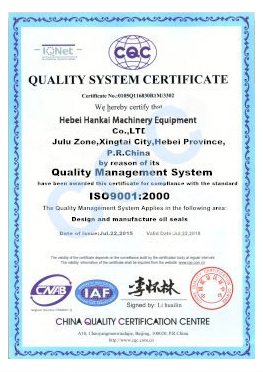Dec . 18, 2024 00:56 Back to list
replacing wiper seal on hydraulic cylinder
Replacing Wiper Seal on Hydraulic Cylinder A Comprehensive Guide
Hydraulic systems are pivotal in various industries, from construction to manufacturing, providing powerful and efficient operations. One essential component of these systems is the hydraulic cylinder, which translates hydraulic pressure into mechanical force. To ensure that hydraulic cylinders operate effectively, routine maintenance is crucial, particularly the replacement of wiper seals. This article will guide you through the process of replacing a wiper seal on a hydraulic cylinder, emphasizing the importance of this task.
Understanding the Importance of Wiper Seals
Wiper seals, also known as dust seals, play a critical role in the performance of hydraulic cylinders. They prevent dirt, debris, and other contaminants from entering the hydraulic cylinder, which can lead to premature wear and tear of internal components. Over time, wiper seals can degrade due to environmental exposure, pressure fluctuations, and temperature variations, making it necessary to replace them periodically. Neglecting this maintenance can result in leaks, decreased efficiency, and ultimately, cylinder failure.
Tools and Materials Needed
Before you start the replacement process, ensure you have the following tools and materials
1. Tools - Wrench set - Screwdrivers (flat and Phillips) - Prying tool or seal puller - Clean cloths - Torque wrench
2. Materials - New wiper seal (compatible with your specific hydraulic cylinder) - Hydraulic oil (if necessary) - Lubricant (such as hydraulic grease)
Step-by-Step Replacement Process
Step 1 Safety Precautions
Before beginning, ensure the hydraulic system is shut down and depressurized. This step is vital to prevent any accidental discharge of hydraulic fluid, which can be dangerous. Use appropriate personal protective equipment (PPE), including gloves and safety goggles.
Step 2 Remove the Cylinder from Equipment
Detach the hydraulic cylinder from the machinery or equipment it is connected to. This process will vary depending on the setup, but generally, you will need to use wrenches to loosen the mounting bolts and carefully slide the cylinder out.
Step 3 Disassemble the Cylinder
Once the hydraulic cylinder is removed, place it on a clean, flat surface. Use the appropriate tools to carefully disassemble the cylinder. Take note of the arrangement of the parts, as you will need to reassemble them later. Remember to keep track of any small components that may fall during disassembly.
replacing wiper seal on hydraulic cylinder

Step 4 Remove the Old Wiper Seal
Locate the old wiper seal at the top of the cylinder. Use a prying tool or seal puller to carefully remove it. Take care not to scratch or damage the cylinder surface, as this can lead to leaks when reassembling.
Step 5 Clean the Cylinder Components
Use a clean cloth to wipe down the cylinder and its components. Remove any dirt, debris, or old lubricant. A clean working environment will help ensure that the new seal functions correctly.
Step 6 Install the New Wiper Seal
Before installing the new wiper seal, apply a small amount of lubricant to the seal and the groove where it will fit. Carefully press the new seal into place, ensuring it sits evenly and securely within the groove.
Step 7 Reassemble the Cylinder
With the new wiper seal installed, reassemble the hydraulic cylinder, reversing the disassembly steps. Ensure all components are in their correct positions, and torque the bolts to the manufacturer’s specifications.
Step 8 Reinstall the Cylinder
Once the hydraulic cylinder is fully reassembled, reinstall it back onto the equipment and secure it properly.
Step 9 Test the System
Finally, once everything is in place, restore power to the hydraulic system and check for leaks. It is crucial to ensure that the new wiper seal is functioning correctly to prevent contamination from entering the cylinder.
Conclusion
Replacing the wiper seal on a hydraulic cylinder is a straightforward yet critical maintenance task that ensures the longevity and efficiency of hydraulic systems. Regular inspection and timely replacement of wiper seals can prevent costly repairs and keep your machinery running smoothly. With the right tools and procedures, anyone can perform this essential maintenance task and contribute to the optimal performance of hydraulic equipment.
-
TCN Oil Seal Metal Ring Reinforcement for Heavy Machinery
NewsJul.25,2025
-
Rotary Lip Seal Spring-Loaded Design for High-Speed Applications
NewsJul.25,2025
-
Hydraulic Cylinder Seals Polyurethane Material for High-Impact Jobs
NewsJul.25,2025
-
High Pressure Oil Seal Polyurethane Coating Wear Resistance
NewsJul.25,2025
-
Dust Proof Seal Double Lip Design for Construction Equipment
NewsJul.25,2025
-
Hub Seal Polyurethane Wear Resistance in Agricultural Vehicles
NewsJul.25,2025
-
The Trans-formative Journey of Wheel Hub Oil Seals
NewsJun.06,2025
Products categories
















